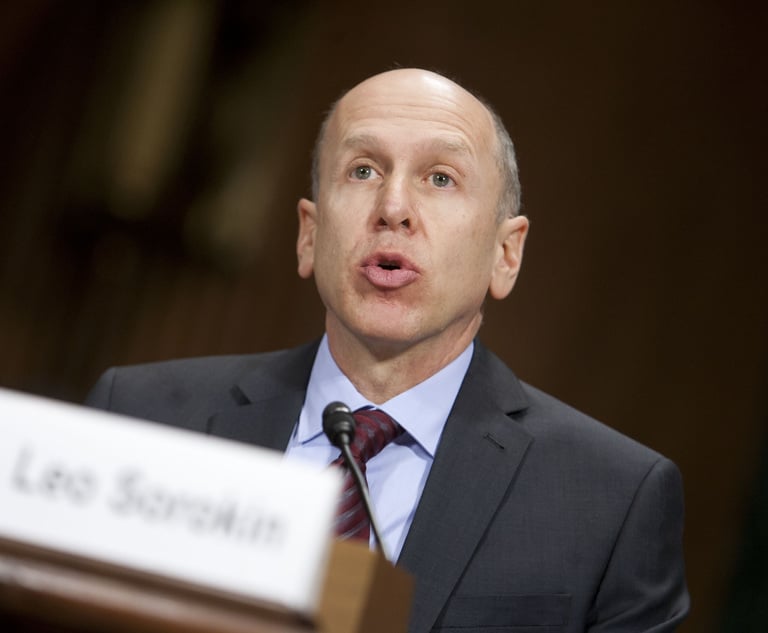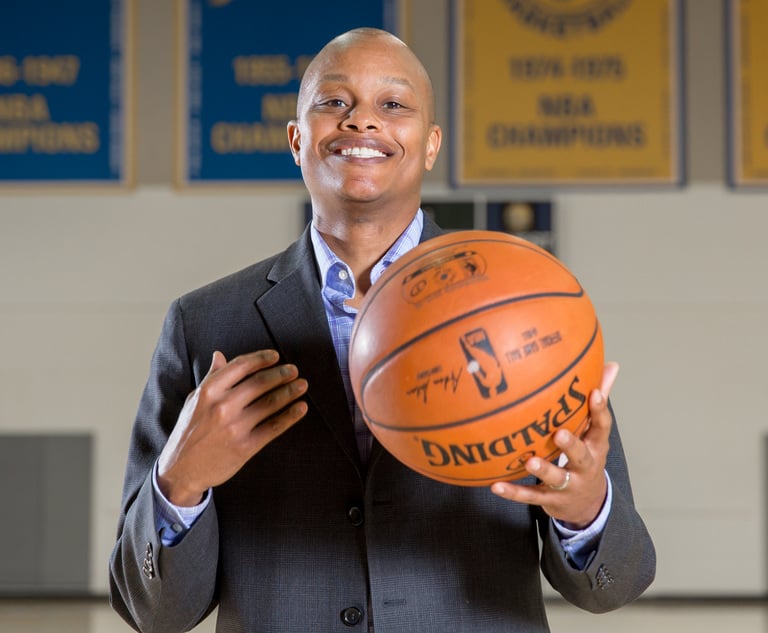SF-Based Compliance.ai Brings Together Law Students and ... AI, Naturally
The tool's concept involves taking “a general counsel in one bank from a siloed approach to compliance, based on one set of decisions, to an expert, crowdsourced approach,” co-founder and CEO Kayvan Alikhani said in a recent interview with Corporate Counsel.
November 01, 2018 at 05:28 PM
4 minute read
 Kayvan Alikhani.
Kayvan Alikhani.
When Kayvan Alikhani, co-founder and CEO of San Francisco-based Compliance.ai, surveyed general counsel at U.S. companies, they told him they were overwhelmed by the sheer volume of regulatory changes by state and federal agencies.
So his company came up with a way to use lawyers, law professors and law students to collaborate on a workflow automation tool for U.S.-based financial services companies, exchanging their work for experience with, and free use of, the company's AI.
The tool's concept involves taking “a general counsel in one bank from a siloed approach to compliance, based on one set of decisions, to an expert, crowdsourced approach,” Alikhani said in a recent interview with The Recorder affiliate Corporate Counsel.
This approach can help the GC or a compliance officer spot patterns, predict regulatory trends and allocate resources accordingly, he added. Alikhani said the company began by using interviews, surveys, analyses and research to look at a day in the life of a regulatory compliance officer and how one manages the volume and content of changes. He said the review found “a huge amount of manual work going into just collecting all the information—rules, regulations, agency guidances, executive orders, notices, work enforcement actions.”
It didn't take much study to realize most companies were under-resourced for the task. Alikhani said, “A midsized organization in the U.S. receives on average one such document every 10 to 15 minutes, from several different jurisdictions—local, state and federal. Hundreds of documents a day.”
Every document has to be studied and analyzed for how it affects each business. The workload was out of control, Alikhani said.
“Now imagine you have thousands of banks in the same markets, selling some of the same products, dealing with the same jurisdictions and the same regulatory agencies. They share a huge amount of commonality, yet each one is doing the same research and analysis independently.”
Compliance.ai joins groups of organizations on the internet using artificial intelligence to classify, rate and rank the changes on a common platform.
The company uses experts—the lawyers, law profs and law students—to extract and prioritize key attributes of regulatory changes and to tell a GC or compliance officer when any change is relevant to her company and why. It's a personalized risk assessment.
Through supervised learning, the human teachers—called contributors—raise the confidence level of the computers.
He said he first recruited law students from the nearby University of San Francisco Law School, then expanded to include law schools at Michigan State University in East Lansing; Washington and Lee University in Lexington, Virginia; Widener University in Wilmington, Delaware; and University of Nevada, Las Vegas.
The business now has 60 to 65 trained student contributors, he said, with some 50 other universities interested in participating. Many of the students hope to boost future careers in fintech, blockchain or cryptocurrency areas by gaining experience with machine learning in the finance industry.
Do they work for free? Well, yes at first, he said, but they work from afar, at their own workstations and computers, and at their own pace.
There are some rewards. The contributors receive free use of the research tool to do their own research or analyses on projects or cases. Those who do good work for the company are recognized with prizes, gift certificates, bonuses or even scholarships, he said.
Those who do outstanding work are hired as paid consultants.
Although focused on U.S. organizations now, Alikhani expects to grow the business into Canada, Europe and the U.K. next. He said he also hopes to recruit students internationally, starting in India.
This content has been archived. It is available through our partners, LexisNexis® and Bloomberg Law.
To view this content, please continue to their sites.
Not a Lexis Subscriber?
Subscribe Now
Not a Bloomberg Law Subscriber?
Subscribe Now
NOT FOR REPRINT
© 2025 ALM Global, LLC, All Rights Reserved. Request academic re-use from www.copyright.com. All other uses, submit a request to [email protected]. For more information visit Asset & Logo Licensing.
You Might Like
View All
On The Move: Squire Patton Boggs, Akerman Among Four Firms Adding Atlanta Partners
7 minute read

Judge Grills DOJ on Trump’s Birthright Citizenship Executive Order

NBA Players Association Finds Its New GC in Warriors Front Office
Trending Stories
- 1States Accuse Trump of Thwarting Court's Funding Restoration Order
- 2Microsoft Becomes Latest Tech Company to Face Claims of Stealing Marketing Commissions From Influencers
- 3Coral Gables Attorney Busted for Stalking Lawyer
- 4Trump's DOJ Delays Releasing Jan. 6 FBI Agents List Under Consent Order
- 5Securities Report Says That 2024 Settlements Passed a Total of $5.2B
Who Got The Work
J. Brugh Lower of Gibbons has entered an appearance for industrial equipment supplier Devco Corporation in a pending trademark infringement lawsuit. The suit, accusing the defendant of selling knock-off Graco products, was filed Dec. 18 in New Jersey District Court by Rivkin Radler on behalf of Graco Inc. and Graco Minnesota. The case, assigned to U.S. District Judge Zahid N. Quraishi, is 3:24-cv-11294, Graco Inc. et al v. Devco Corporation.
Who Got The Work
Rebecca Maller-Stein and Kent A. Yalowitz of Arnold & Porter Kaye Scholer have entered their appearances for Hanaco Venture Capital and its executives, Lior Prosor and David Frankel, in a pending securities lawsuit. The action, filed on Dec. 24 in New York Southern District Court by Zell, Aron & Co. on behalf of Goldeneye Advisors, accuses the defendants of negligently and fraudulently managing the plaintiff's $1 million investment. The case, assigned to U.S. District Judge Vernon S. Broderick, is 1:24-cv-09918, Goldeneye Advisors, LLC v. Hanaco Venture Capital, Ltd. et al.
Who Got The Work
Attorneys from A&O Shearman has stepped in as defense counsel for Toronto-Dominion Bank and other defendants in a pending securities class action. The suit, filed Dec. 11 in New York Southern District Court by Bleichmar Fonti & Auld, accuses the defendants of concealing the bank's 'pervasive' deficiencies in regards to its compliance with the Bank Secrecy Act and the quality of its anti-money laundering controls. The case, assigned to U.S. District Judge Arun Subramanian, is 1:24-cv-09445, Gonzalez v. The Toronto-Dominion Bank et al.
Who Got The Work
Crown Castle International, a Pennsylvania company providing shared communications infrastructure, has turned to Luke D. Wolf of Gordon Rees Scully Mansukhani to fend off a pending breach-of-contract lawsuit. The court action, filed Nov. 25 in Michigan Eastern District Court by Hooper Hathaway PC on behalf of The Town Residences LLC, accuses Crown Castle of failing to transfer approximately $30,000 in utility payments from T-Mobile in breach of a roof-top lease and assignment agreement. The case, assigned to U.S. District Judge Susan K. Declercq, is 2:24-cv-13131, The Town Residences LLC v. T-Mobile US, Inc. et al.
Who Got The Work
Wilfred P. Coronato and Daniel M. Schwartz of McCarter & English have stepped in as defense counsel to Electrolux Home Products Inc. in a pending product liability lawsuit. The court action, filed Nov. 26 in New York Eastern District Court by Poulos Lopiccolo PC and Nagel Rice LLP on behalf of David Stern, alleges that the defendant's refrigerators’ drawers and shelving repeatedly break and fall apart within months after purchase. The case, assigned to U.S. District Judge Joan M. Azrack, is 2:24-cv-08204, Stern v. Electrolux Home Products, Inc.
Featured Firms
Law Offices of Gary Martin Hays & Associates, P.C.
(470) 294-1674
Law Offices of Mark E. Salomone
(857) 444-6468
Smith & Hassler
(713) 739-1250






